B&M Air Raid Sirens: Difference between revisions
ArxCyberwolf (talk | contribs) mNo edit summary |
No edit summary |
||
| (3 intermediate revisions by 2 users not shown) | |||
| Line 1: | Line 1: | ||
{{Infobox | {{Infobox manufacturer|names=<div>Bayless & Miles Siren Manufacturing Company | ||
| | <div>B&M Siren Manufacturing Company | ||
| | <div>B&M|founded=1913|products=<div>Vehicular sirens|hq=13620 Imperial Hwy, Santa Fe Springs, CA 90670|title=B&M Siren Manufacturing Company|image=B&M Logo.png|caption=HELIN's primary logo.}}The ''Bayless & Miles'' (B&M) ''Siren Manufacturing Company'' is a manufacturer of vehicular and stationary electric sirens, and is one of the oldest siren manufacturers, having been in business since 1913. While B&M currently only makes [[B&M Siro-Drift|Siro-Drift]] vehicular sirens, B&M had extensive siren offerings in the early 20th century, ranging from tiny electric alarms to large air raid sirens. B&M was largely forgotten about in the late 20th century during the rise of electronic sirens but persevered into the modern day. Despite all of the challenges the company has faced, B&M still exists today and continues to offer sirens that outperform competitors, as well as restore older products. | ||
| | |||
| | |||
| | |||
== History == | == History == | ||
[[File:B&M rotor.png|left|thumb|160x160px|B&M's unique curved rotor design demonstrated on a full 14 port rotor.]] | [[File:B&M rotor.png|left|thumb|160x160px|B&M's unique curved rotor design demonstrated on a full 14 port rotor.]]Bayless & Miles (B&M) Siren Manufacturing Company was formed in 1913 by James Bayless and Lester Miles, who sought to create friction sirens for motorcycles. The 1st siren produced by B&M was a tiny friction-driven siren named the Model MC. Bayless would leave the company in 1921 after losing interest in sirens, signing over the rights to the company to Miles. B&M began making larger sirens as early as 1927; as World War II began and the Cold War loomed over the horizon, the demand for dual-tone civil defense sirens was rising to distinguish them from single tone fire sirens. B&M introduced a multitude of single and dual toned sirens, ranging from small single rotor sirens suitable for tiny communities to large dual rotor sirens suitable for big cities. B&M sirens had highly efficient rotor designs with curved rotor vanes, combined with screaming high tones that made for painfully loud sirens that could be heard for miles. B&M continued making larger sirens until around 1963 due to heightened competition from other companies with more resources, marketing, and endorsement—qualities which B&M did not have the resources to contend with. | ||
[[File:B&M.jpg|thumb|207x207px|An advert for some of B&M's large air raid sirens.]]Unfortunately, much information about the larger sirens B&M have been lost. B&M themselves lack any records detailing the production and history of these sirens, which they speculate is due to the records from that time period being confiscated by the United States government since the sirens were built for Civil Defense use. As a result, there is a lot of information that is now lost to time as it is unlikely the government still has these records. The B&M Siro-Drift line remained in production and outperformed competing sirens such as those made by the [[Sterling Siren Fire Alarm Co.|Sterling Siren Fire Alarm Company]] and Federal Signal. Unfortunately, in the 1980s many municipalities chose to switch to using electronic sirens instead of mechanical sirens to reduce the load on vehicular electric systems, which caused most customers to stop buying B&M's sirens. As a result, B&M became largely forgotten over the following decades with many believing B&M had gone out of business. In the 2000s, mechanical sirens saw a resurgence in popularity, but the 20 years that had passed caused most to forget B&M existed at all as those who knew of B&M began to retire. | |||
B&M | Because of this, most stations instead went with other options. The company was inherited by B&M employee Kevin O'Connell in 1998, who ran the company until his untimely death from pancreatic cancer in 2019. Another employee named Brian currently runs the company. Despite the aforementioned challenges, B&M still exists today and relies on word of mouth for siren sales; their sirens outperform equivalent competitors and are hand-built in the United States—all products use almost exclusively American-built parts instead of outsourcing them from foreign nations and offer increased longevity and performance compared to other competing products. Along with this, B&M will restore any siren one presents to them. | ||
== Products == | == Products == | ||
=== General Alarm Sirens === | === General Alarm Sirens === | ||
==== Model 6GA ==== | |||
The 6GA is | [[File:B&M 6GA.png|thumb|179x179px|A privately owned Model 6GA, shown without the bell housing.]] | ||
The ''Model 6GA'' is the smallest option in the General Alarm Siren product category, using only a ½ hp motor to drive a 6 in 6-port rotor with a large clutch hub—shared with the Model 6FA friction siren—either above or below the motor. 2 bars bolted to the top and bottom stator plates in front of each stator port prevent debris from entering the rotor or injury from misuse. A cylindrical intake assembly is bolted to the stator. Model 6GA sirens with a motor-over-rotor configuration have exposed motors and 3 legs welded to the bottom of the rotor, with pegs on the base of each allowing the siren to be bolted to a flat surface. Model 6GA sirens with a rotor-over-motor configuration instead have a shielded motor and cylindrical assembly with a flat base and 4 pegs allowing the siren to be bolted to a flat surface. The motor-over-rotor configuration lacks a junction box while the rotor-over-motor configuration includes one incorporated into the motor case. Despite being so tiny and only running on 120 V, the Model 6GA is extremely loud for its size due to the efficient rotor design, with a privately owned unit reaching 130 dBa from up close. The Model 6GA sold under the air raid siren lineup was known as the ''Model 6-AR-1'', branded as a siren for compact suburban areas. Model 6GA sirens were sold with bell shaped shrouds to cover the siren. | |||
==== 8GA ==== | ==== 8GA ==== | ||
The 8GA is | The ''Model 8GA'' is the mid-sized option in the General Alarm Siren product category, using a 1(?) hp motor to drive an 8 in 8-port rotor with no clutch hub—shared with some B&M Siro-Drift offerings—either above or below the motor. 2 bars bolted to the top and bottom stator plates in front of each stator port prevent debris from entering the rotor or injury from misuse. A cylindrical intake assembly is bolted to the stator. Model 8GA sirens with a motor-over-rotor configuration have exposed motors and 3 legs welded to the bottom of the rotor, with pegs on the base of each allowing the siren to be bolted to a flat surface. Model 8GA sirens with a rotor-over-motor configuration instead have a shielded motor and cylindrical assembly with a flat base and 4 pegs allowing the siren to be bolted to a flat surface. The motor-over-rotor configuration lacks a junction box while the rotor-over-motor configuration includes one incorporated into the motor case. Despite being so tiny and only running on 120 V, the Model 8GA is extremely loud for its size due to the efficient rotor design. The Model 8GA sold under the air raid siren lineup was known as the ''Model 8-AR-1''(?), branded as a siren for compact suburban areas. Model 8GA sirens were sold with bell shaped shrouds to cover the siren. Few are known to exist in the wild, as the larger 10GA was a more popular choice. | ||
==== 10GA ==== | ==== 10GA ==== | ||
[[File:B&M Model 10 with housing.png|thumb|188x188px|A privately owned B&M Model 10 next to its weatherproof housing.]]The ''Model 10GA'' is the largest option in the General Alarm Siren product category. Especially popular in Texas and surrounding states, the Model 10GA is 1 of B&M's more common outdoor sirens. The Model 10GA uses a 2½ hp motor to drive a 10 in 8-port rotor with no clutch hub—shared with some B&M Siro-Drift offerings—either above or below the motor. 2 bars bolted to the top and bottom stator plates in front of each stator port prevent debris from entering the rotor or injury from misuse. A cylindrical intake assembly is bolted to the stator. Model 10GA sirens with a motor-over-rotor configuration have exposed motors and 3 legs welded to the bottom of the rotor, with pegs on the base of each allowing the siren to be bolted to a flat surface. Model 10GA sirens with a rotor-over-motor configuration instead have a shielded motor and cylindrical assembly with a flat base and 4 pegs allowing the siren to be bolted to a flat surface. The motor-over-rotor configuration lacks a junction box while the rotor-over-motor configuration includes one incorporated into the motor case. Despite being so tiny and only running on 120 V, the Model 10GA is extremely loud for its size due to the efficient rotor design. The Model 10GA sold under the air raid siren lineup was known as the ''Model 10-AR-2''—being the second smallest siren of that line—branded as a siren for compact suburban areas. Model 10GA sirens were sold with bell shaped shrouds or with fully enclosed shrouds as the ''Model 10''. | |||
=== "Air Raid" Sirens (AR) === | |||
==== 20-AR-7 ==== | ==== 20-AR-7 ==== | ||
The 20-AR-7 is the mid-size dual end AR series siren, with two 20-inch stators and 18 <sup>1/8</sup> inch rotors powered by a 7.5 horsepower motor. A good few units still remain today, albeit inactive or under private ownership. They came in 16/20-port standard, and no remaining examples have a different port ratio. The 16/20-port units are unique by using 8/10-port rotors inside of 16/20-port stators, with the rotor ports the same size as the stator ports. It is believed B&M did this to get more equal sound distribution out of the intakes and ports, leading to more uniform coverage. This would create two octave tones, making for a very odd sounding siren. The 20-AR-7 was best suited for large cities, according to B&M. B&M also offered a single rotor version of this siren, called the '''20-AR'''. Four have been documented, and at least three exist today. | [[File:B&M 20-AR-7.jpg|thumb|160x160px|A privately owned B&M 20-AR-7 with optional intake horns.]]The 20-AR-7 is the mid-size dual end AR series siren, with two 20-inch stators and 18 <sup>1/8</sup> inch rotors powered by a 7.5 horsepower motor. A good few units still remain today, albeit inactive or under private ownership. They came in 16/20-port standard, and no remaining examples have a different port ratio. The 16/20-port units are unique by using 8/10-port rotors inside of 16/20-port stators, with the rotor ports the same size as the stator ports. It is believed B&M did this to get more equal sound distribution out of the intakes and ports, leading to more uniform coverage. This would create two octave tones, making for a very odd sounding siren. The 20-AR-7 was best suited for large cities, according to B&M. B&M also offered a single rotor version of this siren, called the '''20-AR'''. Four have been documented, and at least three exist today. | ||
==== 20-AR-10(•2T) ==== | ==== 20-AR-10(•2T) ==== | ||
The 20-AR-10, or 20AR10•2T, is B&M's largest AR series siren, with two 20-inch stators and 18 <sup>1/8</sup> inch rotors, longer than the rotors on a 20-AR-7 with the same diameter. The 20-AR-10 is driven by a dual shafted 10 horsepower AC motor. It was sold in 12/16-port with 6/8-port rotors, full 14/16-port, and possibly more that may currently be unknown. 6 examples are known to remain today, one being incomplete with only one 14-port rotor and the motor at B&M's facility, a display unit at an Orange County, CA fire station, Sierra Madre, CA's siren, Carlisle, PA's siren, Perris, CA's siren and a display unit at the Mojave Desert Historical & Cultural Association (MDHCA.org) in Goffs, CA. The 20-AR-10 was best suited for widespread metropolitan areas, according to B&M. | [[File:B&M 20-AR-10.png|thumb|160x160px|A 12/16-port 20-AR-10 siren on display, one of the unique units with half-ported 6/8 rotors.]]The 20-AR-10, or 20AR10•2T, is B&M's largest AR series siren, with two 20-inch stators and 18 <sup>1/8</sup> inch rotors, longer than the rotors on a 20-AR-7 with the same diameter. The 20-AR-10 is driven by a dual shafted 10 horsepower AC motor. It was sold in 12/16-port with 6/8-port rotors, full 14/16-port, and possibly more that may currently be unknown. 6 examples are known to remain today, one being incomplete with only one 14-port rotor and the motor at B&M's facility, a display unit at an Orange County, CA fire station, Sierra Madre, CA's siren, Carlisle, PA's siren, Perris, CA's siren and a display unit at the Mojave Desert Historical & Cultural Association (MDHCA.org) in Goffs, CA. The 20-AR-10 was best suited for widespread metropolitan areas, according to B&M. | ||
=== H series === | |||
==== 15-H-2 ==== | ==== 15-H-2 ==== | ||
The 15-H-2 is the smallest siren in the H Series lineup, being just 3 horsepower with two 15-inch rotors. The rotors are 6-port, and the stators are 12-port, making for a heavier undertone. Most likely because of its poor price/performance ratio compared to other models, the 15-H-2 was not a popular choice, being only $50 less than the 15-H-4 at the time. None are known to exist today. | [[File:B&M 15-H-2.png|thumb|160x160px|A B&M 15-H-2 in an advertisement.]]The 15-H-2 is the smallest siren in the H Series lineup, being just 3 horsepower with two 15-inch stators, and likely close to 13 inch rotors. The rotors are 6-port, and the stators are 12-port, making for a heavier undertone. Most likely because of its poor price/performance ratio compared to other models, the 15-H-2 was not a popular choice, being only $50 less than the 15-H-4 at the time. None are known to exist today. | ||
[[File: | [[File:15h4s.png|thumb|159x159px|An inactive B&M 15-H-4, slim intake variant, in Slaughter, LA. Photo by Jackson Purinton]] | ||
==== 15-H-4 ==== | ==== 15-H-4 ==== | ||
The 15-H-4 is the second siren in the H Series lineup, it has two 15-inch rotors driven by a 5 horsepower motor. The 15-H-4 is similar to the 15-H-2, just having longer rotors and a larger motor. Like the 15-H-2, the 15-H-4 is a 6/6-port siren with 12-port stators. All 15-H-4s known to exist have stator flanges for stator shrouds to be mounted, and one 15-H-4 in Kingman, AZ has the stator shrouds and horn extensions on the intakes. The 15-H-4 is the most common siren of the H Series, as it was much cheaper than the largest H Series siren, but only slightly more than the 15-H-2. It is also believed that the 15-H-4 was | The 15-H-4 is the second siren in the H Series lineup, it has two 15-inch stators, and rotors likely close to 13 inches. It is driven by a 5 horsepower motor. The 15-H-4 is similar to the 15-H-2, just having longer rotors and a more powerful motor. Some 15-H-4s also have slightly wider intakes than the 15-H-2, and these units generally have a larger U.S. motor. Like the 15-H-2, the 15-H-4 is a 6/6-port siren with 12-port stators. All 15-H-4s known to exist have stator flanges for stator shrouds to be mounted, and one 15-H-4 in Kingman, AZ has the stator shrouds and horn extensions on the intakes. The 15-H-4 is the most common siren of the H Series, as it was much cheaper than the largest H Series siren, but only slightly more than the 15-H-2. It is also believed that the 15-H-4 was the same as the 15-AR-5, with little to no changes. | ||
==== 18-H-7 ==== | ==== 18-H-7 ==== | ||
The 18-H-7 was the largest siren in the H series lineup, presumably with two 18-inch | The 18-H-7 was the largest siren in the H series lineup, presumably with two 18-inch stators and a 10 horsepower motor. Not much is known about the 18-H-7, as it likely never sold well due to being double the price of a 15-H-4. None have ever been documented, and none are known to exist today. | ||
[[File:B&M Steam Siren.jpg | |||
=== Steam powered siren === | |||
[[File:B&M Steam Siren.jpg|thumb|160x160px|A B&M steam driven siren.]]B&M produced at least one steam powered siren for the Atchison, Topeka & Santa Fe (ATSF) Railway in San Bernardino, California for use at their freight railyards. This 7-port siren has a turbine in the rear which drives the rotor to roughly 4,500 rpm when supplied with steam from the railroad shop it was mounted on. It was expected to be audible as far as 6 miles away in Highland, CA, but whether or not that was met is unknown. One of these sirens was once located on top of a building in the railroad's San Bernardino yard and was used for air raid and general alarms, before being taken out of service and donated to a museum. | |||
== Gallery == | |||
==== | == References == | ||
[[Category:Sirens]] | [[Category:Sirens]] | ||
[[Category:Single Toned Sirens]] | [[Category:Single Toned Sirens]] | ||
Latest revision as of 18:13, 25 November 2024
The Bayless & Miles (B&M) Siren Manufacturing Company is a manufacturer of vehicular and stationary electric sirens, and is one of the oldest siren manufacturers, having been in business since 1913. While B&M currently only makes Siro-Drift vehicular sirens, B&M had extensive siren offerings in the early 20th century, ranging from tiny electric alarms to large air raid sirens. B&M was largely forgotten about in the late 20th century during the rise of electronic sirens but persevered into the modern day. Despite all of the challenges the company has faced, B&M still exists today and continues to offer sirens that outperform competitors, as well as restore older products.
History
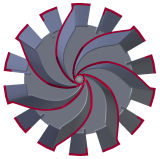
Bayless & Miles (B&M) Siren Manufacturing Company was formed in 1913 by James Bayless and Lester Miles, who sought to create friction sirens for motorcycles. The 1st siren produced by B&M was a tiny friction-driven siren named the Model MC. Bayless would leave the company in 1921 after losing interest in sirens, signing over the rights to the company to Miles. B&M began making larger sirens as early as 1927; as World War II began and the Cold War loomed over the horizon, the demand for dual-tone civil defense sirens was rising to distinguish them from single tone fire sirens. B&M introduced a multitude of single and dual toned sirens, ranging from small single rotor sirens suitable for tiny communities to large dual rotor sirens suitable for big cities. B&M sirens had highly efficient rotor designs with curved rotor vanes, combined with screaming high tones that made for painfully loud sirens that could be heard for miles. B&M continued making larger sirens until around 1963 due to heightened competition from other companies with more resources, marketing, and endorsement—qualities which B&M did not have the resources to contend with.
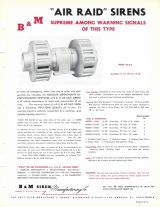
Unfortunately, much information about the larger sirens B&M have been lost. B&M themselves lack any records detailing the production and history of these sirens, which they speculate is due to the records from that time period being confiscated by the United States government since the sirens were built for Civil Defense use. As a result, there is a lot of information that is now lost to time as it is unlikely the government still has these records. The B&M Siro-Drift line remained in production and outperformed competing sirens such as those made by the Sterling Siren Fire Alarm Company and Federal Signal. Unfortunately, in the 1980s many municipalities chose to switch to using electronic sirens instead of mechanical sirens to reduce the load on vehicular electric systems, which caused most customers to stop buying B&M's sirens. As a result, B&M became largely forgotten over the following decades with many believing B&M had gone out of business. In the 2000s, mechanical sirens saw a resurgence in popularity, but the 20 years that had passed caused most to forget B&M existed at all as those who knew of B&M began to retire.
Because of this, most stations instead went with other options. The company was inherited by B&M employee Kevin O'Connell in 1998, who ran the company until his untimely death from pancreatic cancer in 2019. Another employee named Brian currently runs the company. Despite the aforementioned challenges, B&M still exists today and relies on word of mouth for siren sales; their sirens outperform equivalent competitors and are hand-built in the United States—all products use almost exclusively American-built parts instead of outsourcing them from foreign nations and offer increased longevity and performance compared to other competing products. Along with this, B&M will restore any siren one presents to them.
Products
General Alarm Sirens
Model 6GA
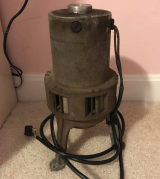
The Model 6GA is the smallest option in the General Alarm Siren product category, using only a ½ hp motor to drive a 6 in 6-port rotor with a large clutch hub—shared with the Model 6FA friction siren—either above or below the motor. 2 bars bolted to the top and bottom stator plates in front of each stator port prevent debris from entering the rotor or injury from misuse. A cylindrical intake assembly is bolted to the stator. Model 6GA sirens with a motor-over-rotor configuration have exposed motors and 3 legs welded to the bottom of the rotor, with pegs on the base of each allowing the siren to be bolted to a flat surface. Model 6GA sirens with a rotor-over-motor configuration instead have a shielded motor and cylindrical assembly with a flat base and 4 pegs allowing the siren to be bolted to a flat surface. The motor-over-rotor configuration lacks a junction box while the rotor-over-motor configuration includes one incorporated into the motor case. Despite being so tiny and only running on 120 V, the Model 6GA is extremely loud for its size due to the efficient rotor design, with a privately owned unit reaching 130 dBa from up close. The Model 6GA sold under the air raid siren lineup was known as the Model 6-AR-1, branded as a siren for compact suburban areas. Model 6GA sirens were sold with bell shaped shrouds to cover the siren.
8GA
The Model 8GA is the mid-sized option in the General Alarm Siren product category, using a 1(?) hp motor to drive an 8 in 8-port rotor with no clutch hub—shared with some B&M Siro-Drift offerings—either above or below the motor. 2 bars bolted to the top and bottom stator plates in front of each stator port prevent debris from entering the rotor or injury from misuse. A cylindrical intake assembly is bolted to the stator. Model 8GA sirens with a motor-over-rotor configuration have exposed motors and 3 legs welded to the bottom of the rotor, with pegs on the base of each allowing the siren to be bolted to a flat surface. Model 8GA sirens with a rotor-over-motor configuration instead have a shielded motor and cylindrical assembly with a flat base and 4 pegs allowing the siren to be bolted to a flat surface. The motor-over-rotor configuration lacks a junction box while the rotor-over-motor configuration includes one incorporated into the motor case. Despite being so tiny and only running on 120 V, the Model 8GA is extremely loud for its size due to the efficient rotor design. The Model 8GA sold under the air raid siren lineup was known as the Model 8-AR-1(?), branded as a siren for compact suburban areas. Model 8GA sirens were sold with bell shaped shrouds to cover the siren. Few are known to exist in the wild, as the larger 10GA was a more popular choice.
10GA
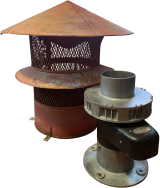
The Model 10GA is the largest option in the General Alarm Siren product category. Especially popular in Texas and surrounding states, the Model 10GA is 1 of B&M's more common outdoor sirens. The Model 10GA uses a 2½ hp motor to drive a 10 in 8-port rotor with no clutch hub—shared with some B&M Siro-Drift offerings—either above or below the motor. 2 bars bolted to the top and bottom stator plates in front of each stator port prevent debris from entering the rotor or injury from misuse. A cylindrical intake assembly is bolted to the stator. Model 10GA sirens with a motor-over-rotor configuration have exposed motors and 3 legs welded to the bottom of the rotor, with pegs on the base of each allowing the siren to be bolted to a flat surface. Model 10GA sirens with a rotor-over-motor configuration instead have a shielded motor and cylindrical assembly with a flat base and 4 pegs allowing the siren to be bolted to a flat surface. The motor-over-rotor configuration lacks a junction box while the rotor-over-motor configuration includes one incorporated into the motor case. Despite being so tiny and only running on 120 V, the Model 10GA is extremely loud for its size due to the efficient rotor design. The Model 10GA sold under the air raid siren lineup was known as the Model 10-AR-2—being the second smallest siren of that line—branded as a siren for compact suburban areas. Model 10GA sirens were sold with bell shaped shrouds or with fully enclosed shrouds as the Model 10.
"Air Raid" Sirens (AR)
20-AR-7
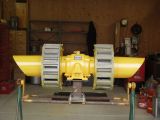
The 20-AR-7 is the mid-size dual end AR series siren, with two 20-inch stators and 18 1/8 inch rotors powered by a 7.5 horsepower motor. A good few units still remain today, albeit inactive or under private ownership. They came in 16/20-port standard, and no remaining examples have a different port ratio. The 16/20-port units are unique by using 8/10-port rotors inside of 16/20-port stators, with the rotor ports the same size as the stator ports. It is believed B&M did this to get more equal sound distribution out of the intakes and ports, leading to more uniform coverage. This would create two octave tones, making for a very odd sounding siren. The 20-AR-7 was best suited for large cities, according to B&M. B&M also offered a single rotor version of this siren, called the 20-AR. Four have been documented, and at least three exist today.
20-AR-10(•2T)
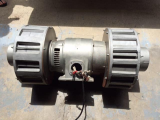
The 20-AR-10, or 20AR10•2T, is B&M's largest AR series siren, with two 20-inch stators and 18 1/8 inch rotors, longer than the rotors on a 20-AR-7 with the same diameter. The 20-AR-10 is driven by a dual shafted 10 horsepower AC motor. It was sold in 12/16-port with 6/8-port rotors, full 14/16-port, and possibly more that may currently be unknown. 6 examples are known to remain today, one being incomplete with only one 14-port rotor and the motor at B&M's facility, a display unit at an Orange County, CA fire station, Sierra Madre, CA's siren, Carlisle, PA's siren, Perris, CA's siren and a display unit at the Mojave Desert Historical & Cultural Association (MDHCA.org) in Goffs, CA. The 20-AR-10 was best suited for widespread metropolitan areas, according to B&M.
H series
15-H-2

The 15-H-2 is the smallest siren in the H Series lineup, being just 3 horsepower with two 15-inch stators, and likely close to 13 inch rotors. The rotors are 6-port, and the stators are 12-port, making for a heavier undertone. Most likely because of its poor price/performance ratio compared to other models, the 15-H-2 was not a popular choice, being only $50 less than the 15-H-4 at the time. None are known to exist today.
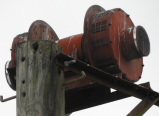
15-H-4
The 15-H-4 is the second siren in the H Series lineup, it has two 15-inch stators, and rotors likely close to 13 inches. It is driven by a 5 horsepower motor. The 15-H-4 is similar to the 15-H-2, just having longer rotors and a more powerful motor. Some 15-H-4s also have slightly wider intakes than the 15-H-2, and these units generally have a larger U.S. motor. Like the 15-H-2, the 15-H-4 is a 6/6-port siren with 12-port stators. All 15-H-4s known to exist have stator flanges for stator shrouds to be mounted, and one 15-H-4 in Kingman, AZ has the stator shrouds and horn extensions on the intakes. The 15-H-4 is the most common siren of the H Series, as it was much cheaper than the largest H Series siren, but only slightly more than the 15-H-2. It is also believed that the 15-H-4 was the same as the 15-AR-5, with little to no changes.
18-H-7
The 18-H-7 was the largest siren in the H series lineup, presumably with two 18-inch stators and a 10 horsepower motor. Not much is known about the 18-H-7, as it likely never sold well due to being double the price of a 15-H-4. None have ever been documented, and none are known to exist today.
Steam powered siren
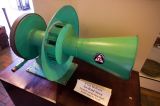
B&M produced at least one steam powered siren for the Atchison, Topeka & Santa Fe (ATSF) Railway in San Bernardino, California for use at their freight railyards. This 7-port siren has a turbine in the rear which drives the rotor to roughly 4,500 rpm when supplied with steam from the railroad shop it was mounted on. It was expected to be audible as far as 6 miles away in Highland, CA, but whether or not that was met is unknown. One of these sirens was once located on top of a building in the railroad's San Bernardino yard and was used for air raid and general alarms, before being taken out of service and donated to a museum.